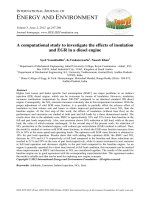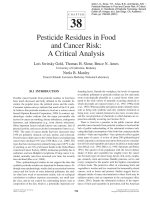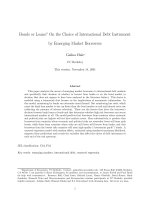The Chemistry of Food and Nutrition, by A. W. Duncan pdf
Bạn đang xem bản rút gọn của tài liệu. Xem và tải ngay bản đầy đủ của tài liệu tại đây (2.03 MB, 299 trang )
The Project
Gutenberg eBook,
The Chemistry of
Food and Nutrition,
by A. W. Duncan
This eBook is for the use of anyone
anywhere at no cost and with
almost no restrictions whatsoever. You may
copy it, give it away or
re-use it under the terms of the Project
Gutenberg License included
with this eBook or online at
www.gutenberg.net
Title: The Chemistry of Food and
Nutrition
Author: A. W. Duncan
Release Date: March 2, 2005 [eBook
#15237]
Language: English
Character set encoding: ISO-8859-1
***START OF THE PROJECT
GUTENBERG EBOOK THE
CHEMISTRY OF FOOD AND
NUTRITION***
E-text prepared by Feòrag
NicBhrìde, Richard Prairie,
and the Project Gutenberg
Online Distributed
Proofreading Team
The Chemistry Of
Food and Nutrition
BY
A. W. DUNCAN, F.C.S.
ANALYTICAL CHEMIST.
MANCHESTER THE VEGETARIAN
SOCIETY
1905
The first edition of 1884 contained but 5
pages of type; the second of 1898, 14
pages. Only by conciseness has it been
possible to give even a summary of the
principles of dietetics within the limit or
this pamphlet. Should there appear in
places an abruptness or incompleteness of
treatment, these limitations must be my
excuse.
Those who wish to thoroughly study the
science of food are referred to the
standard work, "Food and Dietetics," by
Dr. R. Hutchison (E. Arnold, 16s.). The
effects of purin bodies in producing
illness has been patiently and thoroughly
worked out by Dr. Alexander Haig.
Students are referred to his "Uric Acid, an
epitome of the subject" (J. & A.
Churchhill, 1904, 2s.6d.), or to his larger
work on "Uric Acid." An able scientific
summary of investigations on purins, their
chemical and pathological properties, and
the quantities in foods will be found in
"The Purin Bodies of Food Stuffs," by Dr.
I. Walker Hall (Sherratt & Hughes,
Manchester, 1903, 4s.6d.). The U.S.
Department of Agriculture has made a
large number of elaborate researches on
food and nutrition. My thanks are due to
Mr. Albert Broadbent, the Secretary of the
Vegetarian Society, for placing some of
their bulletins in my hands, and for
suggestions and help. He has also written
several useful popular booklets on food of
a very practical character, at from a penny
to threepence each.
Popular literature abounds in unsound
statements on food. It is unfortunate that
many ardent workers in the cause of health
are lacking in scientific knowledge,
especially of physiology and chemistry.
By their immature and sweeping
statements from the platform and press,
they often bring discredit on a good cause.
Matters of health must be primarily based
on experience and we must bear in mind
that each person can at the most have full
knowledge of himself alone, and to a less
degree of his family and intimates. The
general rules of health are applicable to
all alike, but not in their details. Owing to
individual imperfections of constitution,
difference of temperament and
environment, there is danger when one
man attempts to measure others by his own
standard.
For the opinions here expressed I only
must be held responsible, and not the
Society publishing the pamphlet.
Vegetarians, generally, place the humane
as the highest reason for their practice,
though the determining cause of the change
from a flesh diet has been in most cases
bad health.
A vegetarian may be defined as one who
abstains from all animals as food. The
term animal is used in its proper scientific
sense (comprising insects, molluscs,
crustaceans, fish, etc.). Animal products
are not excluded, though they are not
considered really necessary. They are
looked upon as a great convenience,
whilst free from nearly all the objections
appertaining to flesh food.
A.W.D.
The Chemistry of Food
and Nutrition
By A.W. Duncan, F.C.S.
We may define a food to be any substance
which will repair the functional waste of
the body, increase its growth, or maintain
the heat, muscular, and nervous energy. In
its most comprehensive sense, the oxygen
of the air is a food; as although it is
admitted by the lungs, it passes into the
blood, and there re-acts upon the other
food which has passed through the
stomach. It is usual, however, to restrict
the term food to such nutriment as enters
the body by the intestinal canal. Water is
often spoken of as being distinct from
food, but for this there is no sufficient
reason.
Many popular writers have divided foods
into flesh-formers, heat-givers, and bone-
formers. Although attractive from its
simplicity, this classification will not bear
criticism. Flesh-formers are also heat-
givers. Only a portion of the mineral
matter goes to form bone.
Class I.—Inorganic Compounds.
Sub-class 1. Water. 2. Mineral Matter
or Salts.
Class II—Organic Compounds.
1. Non-Nitrogeneous or Ternary
Compounds. a Carbohydrates.
b Oils. c Organic Acids.
2. Nitrogenous Compounds. a Proteids.
b Osseids.
Class III.—Non-Nutritives, Food Adjuncts
and Drugs.
Essential Oils, Alkaloids, Extractives,
Alcohol, &c.
These last are not strictly foods, if we
keep to the definition already given; but
they are consumed with the true foods or
nutrients, comprised in the other two
classes, and cannot well be excluded from
consideration.
Water forms an essential part of all the
tissues of the body. It is the solvent and
carrier of other substances.
Mineral Matter or Salts, is left as an ash
when food is thoroughly burnt. The most
important salts are calcium phosphate,
carbonate and fluoride, sodium chloride,
potassium phosphate and chloride, and
compounds of magnesium, iron and
silicon.
Mineral matter is quite as necessary for
plant as for animal life, and is therefore
present in all food, except in the case of
some highly-prepared ones, such as sugar,
starch and oil. Children require a good
proportion of calcium phosphate for the
growth of their bones, whilst adults
require less. The outer part of the grain of
cereals is the richest in mineral
constituents, white flour and rice are
deficient. Wheatmeal and oatmeal are
especially recommended for the quantity
of phosphates and other salts contained in
them. Mineral matter is necessary not only
for the bones but for every tissue of the
body.
When haricots are cooked, the liquid is
often thrown away, and the beans served
nearly dry, or with parsley or other sauce.
Not only is the food less tasty but
important saline constituents are lost. The
author has made the following
experiments:—German whole lentils,
Egyptian split red lentils and medium
haricot beans were soaked all night (16
hours) in just sufficient cold water to keep
them covered. The water was poured off
and evaporated, the residue heated in the
steam-oven to perfect dryness and
weighed. After pouring off the water, the
haricots were boiled in more water until
thoroughly cooked, the liquid being kept
as low as possible. The liquid was poured
off as clear as possible, from the haricots,
evaporated and dried. The ash was taken
in each case, and the alkalinity of the
water-soluble ash was calculated as
potash (K
2
O). The quantity of water which
could be poured off was with the German
lentils, half as much more than the original
weight of the pulse; not quite as much
could be poured off the others.
G. Lentils. E. Lentils.
Proportion of liquid 1.5 1.25
Soluble dry matter 0.97 3.38
Ash 0.16 0.40
Alkalinity as K
2
O
0.02 0.082
The loss on soaking in cold water, unless
the water is preserved, is seen to be
considerable. The split lentils, having had
the protecting skin removed, lose most. In
every case the ash contained a good deal
of phosphate and lime. Potatoes are rich in
important potash salts; by boiling a large
quantity is lost, by steaming less and by
baking in the skins, scarcely any. The
flavour is also much better after baking.
The usual addition of common salt
(sodium-chloride) to boiled potatoes is no
proper substitute for the loss of their
natural saline constituents. Natural and
properly cooked foods are so rich in
sodium chloride and other salts that the
addition of common salt is unnecessary.
An excess of the latter excites thirst and
spoils the natural flavour of the food. It is
the custom, especially in restaurants, to
add a large quantity of salt to pulse,
savoury food, potatoes and soups. Bakers'
brown bread is usually very salt, and
sometimes white is also. In some persons
much salt causes irritation of the skin, and
the writer has knowledge of the salt food
of vegetarian restaurants causing or
increasing dandruff. As a rule, fondness
for salt is an acquired taste, and after its
discontinuance for a time, food thus
flavoured becomes unpalatable.
Organic Compounds are formed by living
organisms (a few can also be produced by
chemical means). They are entirely
decomposed by combustion.
T h e Non-Nitrogenous Organic
Compounds are commonly called carbon
compounds or heat-producers, but these
terms are also descriptive of the
nitrogenous compounds. These contain
carbon, hydrogen and oxygen only, and
furnish by their oxidation or combustion in
the body the necessary heat, muscular and
nervous energy. The final product of their
combustion is water and carbon dioxide
(carbonic acid gas).
T h e Carbohydrates comprise starch,
sugar, gum, mucilage, pectose, glycogen,
&c.; cellulose and woody fibre are
carbohydrates, but are little capable of
digestion. They contain hydrogen and
oxygen in the proportion to form water,
the carbon alone being available to
produce heat by combustion. Starch is the
most widely distributed food. It is
insoluble in water, but when cooked is
readily digested and absorbed by the
body. Starch is readily converted into
sugar, whether in plants or animals, during
digestion. There are many kinds of sugar,
such as grape, cane and milk sugars.
T he Oils and Fats consist of the same
elements as the carbohydrates, but the
hydrogen is in larger quantity than is
necessary to form water, and this surplus
is available for the production of energy.
During their combustion in the body they
produce nearly two-and-a-quarter times (4
: 8.9 = 2.225) as much heat as the
carbohydrates; but if eaten in more than
small quantities, they are not easily
digested, a portion passing away by the
intestines. The fat in the body is not solely
dependent upon the quantity consumed as
food, as an animal may become quite fat
on food containing none. A moderate
quantity favours digestion and the bodily
health. In cold weather more should be
taken. In the Arctic regions the Esquimaux
consume enormous quantities. Nuts are
generally rich in oil. Oatmeal contains
more than any of the other cereals (27
analyses gave from 8 to 12.3 per cent.)
The most esteemed and dearest oil is
Almond. What is called Peach-kernel oil
(Oleum Amygdalæ Persicæ), but which in
commerce includes the oil obtained from
plum and apricot stones, is almost as
tasteless and useful, whilst it is
considerably cheaper. It is a very
agreeable and useful food. It is often
added to, as an adulterant, or substituted
for the true Almond oil. The best qualities
of Olive oil are much esteemed, though
they are not as agreeable to English taste
as the oil previously mentioned. The best
qualities are termed Virgin, Extra Sublime
and Sublime. Any that has been exposed
for more than a short time to the light and
heat of a shop window should be rejected,
as the flavour is affected. It should be kept
in a cool place. Not only does it vary
much in freedom from acid and rancidity,









